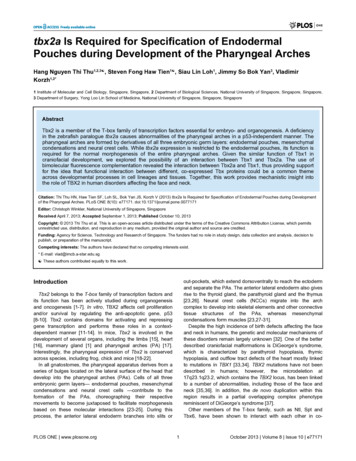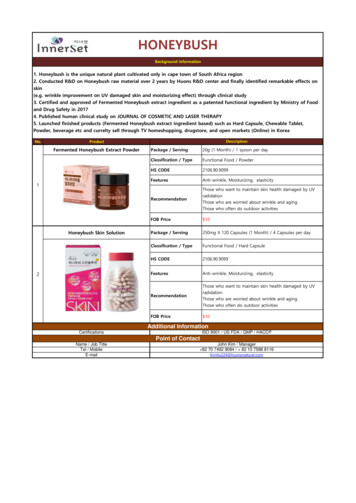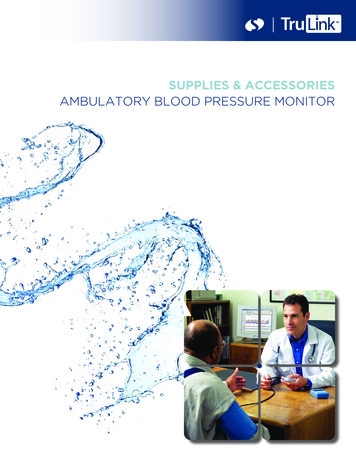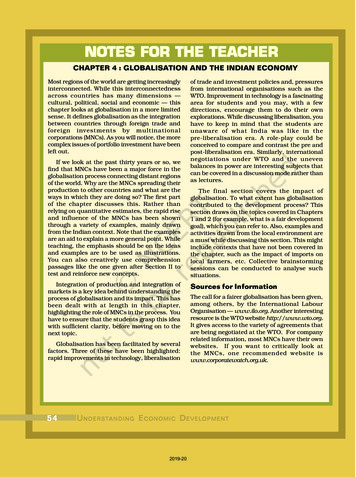
Transcription
tbx2a Is Required for Specification of EndodermalPouches during Development of the Pharyngeal ArchesHang Nguyen Thi Thu1,2,3 , Steven Fong Haw Tien1 , Siau Lin Loh1, Jimmy So Bok Yan3, VladimirKorzh1,2*1 Institute of Molecular and Cell Biology, Singapore, Singapore, 2 Department of Biological Sciences, National University of Singapore, Singapore, Singapore,3 Department of Surgery, Yong Loo Lin School of Medicine, National University of Singapore, Singapore, SingaporeAbstractTbx2 is a member of the T-box family of transcription factors essential for embryo- and organogenesis. A deficiencyin the zebrafish paralogue tbx2a causes abnormalities of the pharyngeal arches in a p53-independent manner. Thepharyngeal arches are formed by derivatives of all three embryonic germ layers: endodermal pouches, mesenchymalcondensations and neural crest cells. While tbx2a expression is restricted to the endodermal pouches, its function isrequired for the normal morphogenesis of the entire pharyngeal arches. Given the similar function of Tbx1 incraniofacial development, we explored the possibility of an interaction between Tbx1 and Tbx2a. The use ofbimolecular fluorescence complementation revealed the interaction between Tbx2a and Tbx1, thus providing supportfor the idea that functional interaction between different, co-expressed Tbx proteins could be a common themeacross developmental processes in cell lineages and tissues. Together, this work provides mechanistic insight intothe role of TBX2 in human disorders affecting the face and neck.Citation: Thi Thu HN, Haw Tien SF, Loh SL, Bok Yan JS, Korzh V (2013) tbx2a Is Required for Specification of Endodermal Pouches during Developmentof the Pharyngeal Arches. PLoS ONE 8(10): e77171. doi:10.1371/journal.pone.0077171Editor: Christoph Winkler, National University of Singapore, SingaporeReceived April 7, 2013; Accepted September 1, 2013; Published October 10, 2013Copyright: 2013 Thi Thu et al. This is an open-access article distributed under the terms of the Creative Commons Attribution License, which permitsunrestricted use, distribution, and reproduction in any medium, provided the original author and source are credited.Funding: Agency for Science, Technology and Resaerch of Singapore. The funders had no role in study design, data collection and analysis, decision topublish, or preparation of the manuscript.Competing interests: The authors have declared that no competing interests exist.* E-mail: vlad@imcb.a-star.edu.sg These authors contributed equally to this work.Introductionout-pockets, which extend dorsoventrally to reach the ectodermand separate the PAs. The anterior lateral endoderm also givesrise to the thyroid gland, the parathyroid gland and the thymus[23,26]. Neural crest cells (NCCs) migrate into the archcomplex to develop into skeletal elements and other connectivetissue structures of the PAs, whereas mesenchymalcondensations form muscles [23,27-31].Despite the high incidence of birth defects affecting the faceand neck in humans, the genetic and molecular mechanisms ofthese disorders remain largely unknown [32]. One of the betterdescribed craniofacial malformations is DiGeorge’s syndrome,which is characterized by parathyroid hypoplasia, thymichypoplasia, and outflow tract defects of the heart mostly linkedto mutations in TBX1 [33,34]. TBX2 mutations have not beendescribed in humans; however, the microdeletion at17q23.1q23.2, which contains the TBX2 locus, has been linkedto a number of abnormalities, including those of the face andneck [35,36]. In addition, the de novo duplication within thisregion results in a partial overlapping complex phenotypereminiscent of DiGeorge’s syndrome [37].Other members of the T-box family, such as Ntl, Spt andTbx6, have been shown to interact with each other in co-Tbx2 belongs to the T-box family of transcription factors andits function has been actively studied during organogenesisand oncogenesis [1-7]. In vitro, TBX2 affects cell proliferationand/or survival by regulating the anti-apoptotic gene, p53[8-10]. Tbx2 contains domains for activating and repressinggene transcription and performs these roles in a contextdependent manner [11-14]. In mice, Tbx2 is involved in thedevelopment of several organs, including the limbs [15], heart[16], mammary gland [1] and pharyngeal arches (PA) [17].Interestingly, the pharyngeal expression of Tbx2 is conservedacross species, including frog, chick and mice [18-22].In all gnatostomes, the pharyngeal apparatus derives from aseries of bulges located on the lateral surface of the head thatdevelop into the pharyngeal arches (PAs). Cells of all threeembryonic germ layers— endodermal pouches, mesenchymalcondensations and neural crest cells —contribute to theformation of the PAs, choreographing their respectivemovements to become juxtaposed to facilitate morphogenesisbased on these molecular interactions [23-25]. During thisprocess, the anterior lateral endoderm branches into slits orPLOS ONE www.plosone.org1October 2013 Volume 8 Issue 10 e77171
tbx2a in Endodermal Pouchexpression domains to exert regulatory activity [38]. This isachieved via the formation of homo- or heterodimers that bindat duplicated palindromic T-box sites [39,40]. Thus, it would beinformative to characterize T-box protein function in a focaldomain/tissue to elucidate the respective interacting molecularnetwork. Given the overlap in the expression of tbx1 and tbx2ain the early stages of PA formation, Tbx1 and Tbx2a may formfunctional heterodimers. In this study, we report the role oftbx2a in the development of PAs in zebrafish. We demonstratethat tbx2a is primarily required for morphogenesis of theendodermal pouches, and subsequently affects thedevelopment of mesenchymal condensations and NCCdifferentiation. Our results support this idea and demonstratethat Tbx2a function is essential and non-redundant in themorphogenesis of the PAs.different sites: MO1, which targets the splice donor site ofintron 1; MO2, which targets the splice acceptor site of intron 1;and MO3, which targets the splice acceptor site of intron 5.These three MOs target the T-box domain or thetransactivation domain, both of which are essential for theprotein’s function [42]. All MOs worked at high efficiency andproduced similar phenotypes that correlated with theexpression pattern of tbx2a. The MO-injected embryos(morphants) survived up to 7 days post-fertilization (dpf). Thedevelopmental defects included dysmorphic PAs, small ears,malformed anus, curved body, cardiac edema, enlarged yolksac and a failure of swim bladder inflation (Figure 2A). Of thethree MOs, MO2 was the most efficient (0.1-0.2 pmole/embryo). We sequenced the aberrant transcript generated afterMO2 injection and found that the resulting mRNA lacked theentire intron 2 caused by the introduction of a premature stopcodon immediately preceding exon 3 (Figure 2B, C). Thus,MO2 led to the formation of a non-functional Tbx2a peptide thatlacked both the DNA binding T-box and the 3’-transactivationdomains [43]. It has been shown that Tbx2 transcriptionallyrepresses connexin 43 (cx43) [13,44]. In MO2 morphants,cx43a expression was upregulated in the ventral diencephalon,where tbx2a was expressed (Figure 2D–F). This suggestedthat MO2 efficiently down-regulated Tbx2a function. As such,MO2 was used in all subsequent experiments.We first tested the involvement of p53 in this system. Coinjection of MO2 and p53 MO resulted in the same phenotypeas that of MO2 alone; this ruled out a p53-mediated nonspecificeffect of the MO (data not shown). Given the deficiency of thePAs in Tbx2a morphants, we next focused our attention on therole of Tbx2a in the organs that derive from this structure. TheGFP transgenic line ET33-1B, a transposon remobilizationderivative of ET33, was previously obtained in a Tol2-mediatedenhancer trap screen and found to map to Chr.16: 35255049 inthe intron of me1 [45]. This line shows strong GFP expressionin the PAs, cleithrum and swim bladder (Figure 3A, Figure S1).Me1 expression is under the control of thyroid hormone andplays a role during the formation of the PAs [46,47]. Thus, thistransgenic line represents a sensitive tool to study PAmorphogenesis in vivo. At 96 hpf, MO2 morphants of ET33-1Bdisplayed disorganization of all PAs (Figure 3B), with amalformed hyoid and defective cartilage in posterior PAs(Figure 3C, D) as demonstrated using Alcian Blue staining [48].This cartilage defect may be attributed to the undevelopedmesenchymal condensation of NCCs and mesodermal cells[23]. Since tbx2a is also expressed in the hindbrain, but not inthe mesodermal core (Figure 1D), this patterning defect in theNCC-derived cartilage may have originated from changes inthe hindbrain organization. However, we found that theexpression of the hindbrain marker hoxa2 [49] was not affectedin the morphants, indicating no significant change in thehindbrain organization (Figure S2A-F).We next examined the migration of NCCs using the dlx2aprobe [50]. By 24 hpf, NCCs migrated as streams of dlx2apositive cells that appeared as three distinct groups in both themorphants and controls (Figure 3C-D). During development,the formation of the endodermal pouches further separatesthese three groups of NCCs into seven mesenchymalResultstbx2a is co-expressed with tbx1 in the endoderm of thePAstbx2a transcripts were first detected by WISH at 11 hpf; by14 hpf, tbx2a transcripts were identified in the dorsal eyeprimordia, the otic placode and mesoderm lateral to the oticplacode, the ventral diencephalon and as two lateral stripes ofthe intermediate mesoderm contributing to the pronephricepithelia (Figure 1A). At 20 hpf, tbx2a expression at low levelappeared in rhombomere 2 (Figure 1B, D), and in thepronephric ducts (Figure 1C). By 24 hpf, the expressionappeared as two stripes of cells proximal to the eyes (Figure1D); these stripes will later develop into the mandibular andhyoid arch mesenchyme. tbx2a expression was also detectedin the olfactory placode, ventral diencephalon, pectoral fin budsand anterior gut at this time point (Figure 1D). By 48 hpf, thetranscript was detected in a thin layer of cells lining the yolkthat will later form the common cardinal vein (Figure 1E). tbx2aexpression was also detected in the liver (Figure 1F), the swimbladder primordium (Figure 1G ), and in the pectoral fins(Figure 1H). A close inspection of the PAs showed tbx2aexpression in the endodermal pouches, but not in the dlx2apositive NCC-derived compartment (Figure 1I, J and K). Insummary, tbx2a is expressed in many domains that areevolutionarily conserved from teleosts to mammals accordingto the common ancestral origin of these organs duringevolution [41].Interestingly, the expression pattern of tbx2a in the PAs isreminiscent of that of tbx1, which shown to play a role in PAdevelopment [33]. In endodermal pouches, we identified tbx1transcripts co-localized with tbx2a transcripts (Figure 1L, M andN). However, here the tbx1 expression domain covered the fulllength of the pouches; i.e., tbx1 expression appeared broaderthan that of tbx2a, which covered only the most ventral part ofthe pouches.Tbx2a is required for development of the PAstbx2a is expressed only zygotically and here we showed thatits expression was detected after 10 hpf by both WISH and RTPCR. To investigate the developmental role of tbx2a, we usedthree antisense morpholino oligonucleotides (MOs) to targetPLOS ONE www.plosone.org2October 2013 Volume 8 Issue 10 e77171
tbx2a in Endodermal PouchFigure 1. Expression pattern of tbx2a during development as detected by whole-mount in situ hybridization (WISH) (14-48hpf). (A) Lateral view of 14 hpf embryo. Lateral-dorsal view of 20 hpf embryo (B) hindbrain and (C) lateral view of the anus. (D)Composite image showing a dorsal view of 26 hpf embryo. (E-K) 48 hpf embryo. (E) Dorsal view of the hindbrain. (F) Lateral view atthe level of somite 2. (G) Lateral view of the swim bladder. (H) Dorsal view of the pectoral fins. (I-K) Pharyngeal arches in a (I)ventral view and in (J-K) sagittal sections. Two-color WISH for (K) dlx2 (magenta) and tbx2a (red), (L-N) tbx2a (magenta) and tbx1(red). Abbreviations for all figures: a: anus; pa: pharyngeal arches; ccv: common cardinal vein; e: ear; ep: endodermal pouch; g: gut;r: retina; r2: rhombomere 2; ht: hypothalamus; h: hours post-fertilization; li: liver; lm: lateral mesoderm; n: nasal pits; ncc: neuralcrest cells; pf: pectoral fin; pn: pronephric ducts; sb: swim bladder; v: vagal nucleus.doi: 10.1371/journal.pone.0077171.g001tbx2a is required for late development of endodermalpouchescondensations and the double (dlx2/tbx2a) in situ stainingagain illustrates the fact that tbx2a is not expressed in the NCC(Figure 3F; [23]). However, in the morphants, this process wasaffected, with endodermal pouches failing to out-pocket andmesenchymal condensation becoming fused (arrows andasterisks, Figure 3G). Taken together, these resultsdemonstrated that tbx2a is not involved in the patterning andmigration of NCCs, but is required for proper mesenchymalcondensation and subsequent cartilage differentiation.PLOS ONE www.plosone.orgAlthough tbx2a expression was restricted to the endodermalcompartment of the arches, its knock-down affected normalformation of the entire PA; this indicated the possible masterrole of tbx2a during PA development. To evaluate thispossibility, we analyzed induction of the endodermal pouchesbetween control and morphant embryos using nkx2.3, aspecific marker of the endodermal pouch. nkx2.3 is expressed3October 2013 Volume 8 Issue 10 e77171
tbx2a in Endodermal PouchFigure 2. Morpholino activity. (A) 48 hpf live MO1/MO2/MO3-injected embryos (doses of 0.5 pmole/0.1 pmole/0.1 pmole,respectively) exhibit hydrocephalus, heart edema (arrow), body curvature, and reductions to the ears and eyes (arrow). (B)Amplified mature transcripts of MO2 morphants on a 0.8% agarose gel. Only one mature transcript is present in the WT, withreduction of the transcript detected in morphants injected with MO2. An additional small transcript was detected caused by thebinding of MO2 to the acceptor site of intron 1 and excision of a fragment containing intron 1, exon 2 and intron 2. (C) Maturetranscript results from joining of exon 1 and exon 3 and a frame shift-induced stop codon (TAA-black box) at the beginning of exon3. cx43a expression is normally absent in the ventral diencephalon of control embryos (D), but is ectopically activated in the tbx2amorphants, (E) in the domain of tbx2a expression, and (F) in the ventral diencephalon.doi: 10.1371/journal.pone.0077171.g002in the five domains between the six PAs [51]. In a ventral view,nkx2.3 revealed five pouches present in both the control andmorphant embryos (Figure 4A, B), suggesting that induction ofthe endodermal pouches is not dependent on Tbx2a function.However, sagittal sections showed severely shortened nkx2.3expression domains in the morphants as compared to controls(Figure 4C, D), suggesting a failure of the endodermal pouch toelongate and interdigitate with the NCC-derived compartmentalong the proximodistal axis. This correlates well with the tbx2aexpression observed in the ventral aspect of the pouches. Thethymus primordium appears in zebrafish larvae at 54 hpf as aderivative of the caudal half of endodermal pouch 3 [52]. Incontrols, we identified maturing B and T lymphocytes of thethymus from 96 hpf (Figure 3E) with positive rag1 staining [53].However, in the morphants, the thymus was not detected(Figure 3F), further illustrating the endodermal pouchdeficiency caused by down-regulation of tbx2a.To demonstrate that the endodermal pouches are essentialfor the morphogenesis of an entire arch complex, we knockeddown tbx2a expression selectively in the endodermal pouches.Previous studies have shown that injection of mRNA encodingthe constitutively active Taram-A (Taram-A*) type I subunit ofthe TGF-β receptor [54] into a 16-cell stage single blastomerePLOS ONE www.plosone.orgcan direct progenitors of the marginal blastomere to develop asanterior endodermal derivatives [55]. We found that embryosco-injected with 0.6 pg mRNA of Taram-A* and 70 kDfluorescein dextran developed normally with unilaterally labeledendodermal pouches of the PAs (Figure 5A). However, in theexperimental embryos, the further addition of 0.05 pmole MO2severely affected the cartilage of the posterior arches on theinjected side, as observed with Alcian Blue staining (Figure 5B,C). This phenotype was partially rescued by adding 10-15 pg oftbx2a mRNA into the injection mix. In this case, about 30% ofinjected embryos developed discrete pouches extending alongthe full length of the dorsoventral axis (Figure 5D, E, G; n 10/32). These results are significant in view of the dosesensitive effects of the T-box proteins [56].Tbx2 interacts with Tbx1Given the expression patterns of tbx1 and tbx2a and thephenotypes of embryos deficient in Tbx1 and Tbx2a are rathersimilar ([33]; this paper), we proposed that these proteinsinteract during PA development. The expression levels of tbx1and tbx2a were measured after reciprocal knock-down. RTPCR did not detect obvious changes in the expression of tbx1,4October 2013 Volume 8 Issue 10 e77171
tbx2a in Endodermal PouchFigure 4. nkx2.3 expression. nkx2.3 is expressed in thesegmented endodermal pouches in control (A, C) andmorphant embryos. These segmented endodermal pouchesare almost fused in the morphants (B, D). The rag1-positivethymus, a derivative of the endodermal pouch (E) is absent inthe morphant (F). A: anterior, P: posterior.doi: 10.1371/journal.pone.0077171.g004A’, A”). The constructs containing a small fragment of Tbx1 Cterminus (385 to 451) containing nuclear localization signal [59]tagging VN/VC served as negative controls (Figure 7B, B’, B”and 7C, C’, C”). These are VN-Tbx1NLS and VC-Tbx1NLS thatlocalize to the nucleus (data not shown), but unable to interactdirectly with Tbx2a. In these control experiments we observeda background nuclear fluorescence, which was significantlylower than that in the experimental sets. Indeed, obviousnuclear fluorescence was detected only after transfecting acombination of VN-Tbx2a and VC-Tbx1 (Figure 7D, D’, D”) orVN-Tbx1 and VC-Tbx2a (Figure 7E, E’, E”; Table S1). Theseresults suggested that during PA development Tbx2a and Tbx1might interact upon binding to DNA.Figure 3.Knock-down of tbx2a affects pharyngealarches. (A, B) tbx2a knock-down results in a loss of GFPpositive pharyngeal arches visualized on a background ofET33-1B transgenics. Alcian Blue-stained cartilages arepresent in the pharyngeal arches of tp53 morphant (C), but notin the tbx2a/tp53 morphants (D). At 24 hpf, dlx2a-positivestreams of migratory NCCs (C) develop normally in themorphant (D) even after injection of a high dose of MO (E). At48hpf, the patterning of posterior arches is affected (arrowsand asterisks in F, G).doi: 10.1371/journal.pone.0077171.g003when tbx2a was knocked down using different doses of MOsand vice versa (Figure 6A, B) suggesting that neither one generegulates the other.It is known that T-box proteins bind to the T-domainpalindrome DNA sequence as dimers [57]. We asked whetherTbx2a and Tbx1 interact upon binding to DNA duringdevelopment of PA. To detect an interaction between Tbx2aand Tbx1, the BiFC system [58] was adapted. tbx1 and tbx2awere N-terminal tagged by VN154m10 and VC155 to produceDNA constructs encoding fusion proteins of VN-Tbx1, VCTbx1, VN-Tbx2a and VC-Tbx2a. These experiments wereperformed in HEK 293T cells. The HEK 293T cells were plated(2x105) and then transfected with 0.2-0.4 µg of DNA of eachconstruct in pairs. In controls with blank VN and VC constructs,fluorescent cells were extremely rare (several cells per 3.5 cmplate) with both nuclear and cytoplasmic fluorescence, whichlikely resulted from aberrant excessive transfection (Figure 7A,PLOS ONE www.plosone.orgDiscussiontbx2a affects the development of the PAs by regulatingendodermal pouch specificationTbx2 expression in the PAs is conserved across speciessuggesting the importance of this gene during craniofacialdevelopment. We report in this study that tbx2a is involved inthe late morphogenesis of endodermal pouches. In theabsence of Tbx2a function, endodermal pouches failed toelongate along the dorsoventral axis towards the epidermalsurface. Therefore, although tbx2a is not involved inendodermal segmentation, it is required for pouch outgrowth. Itis known that F-actin accumulation at the apical surfaces ofcells in the pouch is necessary to direct and constrain themovement of endodermal cells into a narrow group with a slit-5October 2013 Volume 8 Issue 10 e77171
tbx2a in Endodermal PouchFigure 5. Endodermal pouch-specific knock-down of tbx2a causes an anomaly of the pharyngeal arches rescued by tbx2amRNA. (A) Taram-A* (tar*) mRNA injected into the marginal blastomere at the 16-cell stage gives rise to mesendoderm, fromwhich the endodermal pouches derive. (B) Co-injection with MO2 affects the posterior pharyngeal arches (crosses). (C) Alcian Bluestaining viewed under bright field microscope. Confocal imaging of the endodermal pouches upon co-injection with fluorescent dyeand tar* mRNA in the (D) control and (E) the morphants co-injected with MO2. These morphants exhibit shortened and thickenedendodermal pouches. (F) Western blot of total lysates from c-myc-tagged tbx2a mRNA-injected embryos (lane 1, 20 µg; lane 2, 100µg) and non-injected embryos (lane 1’, 20 µg; lane 2’, 100 µg). (G) Rescued MO2-injected morphants with tbx2a mRNA showelongated endodermal pouches.doi: 10.1371/journal.pone.0077171.g005like shape [60,61]. Because N-cadherin connects to the actincables, it may also be involved in the regulation of pouchmorphogenesis. T-box factors have been shown to regulatecell adhesion molecules (e.g., cx43) and play roles in cellattachment and migration [12,62]. A remodeling of celladhesion dynamics might be a constitutive part of the tbx2adependent mechanism that regulates morphogenesis of the PAendoderm. Development of the endodermal pouch has aleading regulatory role in the development of the PAs[23-25,61,63], and our data provide strong support for the roleof tbx2a in this aspect of PA formation. The effect of tbx2a onother cell lineages is indirect and could be due to disturbancesin the regulatory interactions between endodermal pouchesPLOS ONE www.plosone.organd other cells contributing to PA development, which probablytake place downstream of Tbx2a.Although Tbx2 is expressed in the PA in mice, its specificfunction in this organ is not well documented. In chick, Tbx2 isexpressed in both the PA epithelium and mesenchyme. Incontrast, two zebrafish paralogues, tbx2a and tbx2b, areexpressed in the PAs in a complementary manner; i.e., whilethe expression of tbx2a is restricted to the endodermalpouches, tbx2b is expressed in the arch mesenchyme (data notshown). This split in expression probably results in discretefunctions of these two paralogues. Elucidating their respectiveroles in each compartment may reveal critical interactions6October 2013 Volume 8 Issue 10 e77171
tbx2a in Endodermal PouchFigure 6. Tbx2a and Tbx1 do not regulate expression of each other. Fold-change of the expression level of Tbx2a and Tbx1relative to the control (1x change) at 30 hpf. (A) tbx2a MO2 and MO3 had no significant effect on the expression of tbx1. (B) tbx1MO had no significant effect on the expression of tbx2a.doi: 10.1371/journal.pone.0077171.g006of either Tbx1 or Tbx2a produced PA defects with a similardegree of severity.Our study reveals a role for tbx2a during the development ofthe endodermal component of the PAs. This functional analysishas shown for the first time that tbx2a is indispensable formorphogenesis, but not induction, of the pharyngealendodermal pouches. These defects of the endodermalpouches in turn affect proper mesenchymal condensations.Whereas NCC induction and migration are initially independentof the activity of Tbx2a, their late differentiation into cartilagedepends on Tbx2a function. Importantly, our data suggest thatTbx2a may interact with Tbx1 to co-regulate the developmentof the PAs and this process plays a role during craniofacialdevelopment. Further studies to support this hypothesis arewarranted.between the various compartments of the arch during PAdevelopment.Tbx2 and Tbx3 often co-express and act redundantly in theiroverlapping domains [64,65]. However, zebrafish tbx3 is notexpressed in the endodermal pouches ([66]; data not shown).In mice, a Tbx2-null mutation results in hypoplastic PAs [17],while double mutations in Tbx2 and Tbx3 cause severe defectsin the PAs accompanied by improper segmentation [67].However, in this study, we show that Tbx2a ablation alone issufficient to disturb the specification of the endodermalpouches in zebrafish.The endodermal pouches regulate cartilage developmentduring PA formation. Here, Tbx2a may interact with some otherTbx proteins. The expression pattern of Tbx2a is similar to thatof Tbx1, and the loss of function after Tbx2a knock-down israther similar to that observed in vgo mutants that are deficientin Tbx1 [33]. In this study, we provide for the first timemolecular evidence of heterodimerization between Tbx1 andTbx2a. The data suggest that the Tbx1/Tbx2a heterodimercould be an essential regulatory component in the developmentof the zebrafish endodermal pouches. This opens up thepossibility that regulatory T-box heterodimers may be commoncomponents of the developmental mechanism acting in parallelwith T-box homodimers.Interestingly, craniofacial abnormalities reminiscent of theTbx1-linked DiGeorge’s syndrome have been observed inpatients with a microdeletion at 17q21-22, leading to TBX2haploinsufficiency [35,36]. The partial duplication of this regionresulted in a complex phenotype similar to that seen in patientswith DiGeorge’s syndrome [37]. Recently, Tbx1, Tbx2 andTbx3 have been proposed to form an interacting network whereTbx2/3 act as modifiers, and it has been suggested that adeficiency in either Tbx2 or Tbx3 could result in thedevelopment of a phenotype reminiscent of the cardiopharyngeal phenotype found in TBX1-haploinsufficient22q11.2DS patients [67]. In zebrafish, we show that thefunctions of Tbx1 and Tbx2a are non-redundant, since the lossPLOS ONE www.plosone.orgMaterials and MethodsFish maintenanceThe experiments using the wild type AB and the transgenicline SqET33-1B [45] zebrafish (Danio rerio) were performedaccording to the regulations of the Fish Facility (IMCB,Singapore) approved by the Institutional Animal Care and UseCommittee (IACUC) rules (Biopolis IACUC approval #090430).The embryos were maintained at 28.5 C and staged in hourspost fertilization (hpf). Pigment formation was inhibited with theuse of 0.003% 1-phenyl-2-thiourea (PTU, 0.2 mM) from 22 hpf[68].Cloning of tbx2a geneTotal RNA was isolated using RNeasy Mini Kit (Qiagen,Hilden, Germany). RT-PCR was performed with Qiagen OneStep RT-PCR Kit. Full-length tbx2a was obtained withprimers (Forward) 5’-GCTATGGCTTATCACCCTTTTC-3’ and(Reverse) 5’-GAAGTTTTGCGCTTTATGTCACA-3’, based onthe sequence in ENSEMBLE (http://www.ensembl.org,transcript ID ENSDART00000024207). This DNA was cloned7October 2013 Volume 8 Issue 10 e77171
tbx2a in Endodermal PouchFigure 7. Cloned-Tbx1 and Tbx2a in Venus constructs co-localized in the nucleus of transfected 293T cells. Cells were cotransfected with 0.5 µg blank Venus constructs - VN and VC, only a few cells fluoresced in cytoplasm and nucleus (A, A’, A”). A fewcells amongst those co-transfected with 0.5 µg VN-Tbx2a and VC-Tbx1NLS (B, B’, B”) or 0.5 µg VN-Tbx1NLS and VC-Tbx2a (C,C’, C”) fluoresced weakly. In contrast, cells nuclei co-transfected with 0.5 µg VN-Tbx2a and VC-Tbx1 (D, D’, D”) or 0.5 µg VN-Tbx1and VC-Tbx2a (E, E’, E”) fluoresced in many cells. Statistical data are shown in Table S1.doi: 10.1371/journal.pone.0077171.g007PLOS ONE www.plosone.org8October 2013 Volume 8 Issue 10 e77171
tbx2a in Endodermal Pouchinto pGEM T Easy vector (Promega, Madison, WI) forantisense RNA probe synthesis or subcloned into pCMV-Tag5A vector (Stratagene, USA) for sense mRNA synthesis.ImageJ (NIH, Bethesda, MA) was used to estimate dot intensityfor DNA bands on agarose gel images. Motif searches wereperformed with MyHits 2003-2009 (http://myhits.isb-sib.ch/cgi-bin/clustalw).DIG) for the detection of different genes. All the in situ stainingwas done using 20-30 embryos/set and conclusions weredrawn from a phenotype prevalent in 70-90% of embryos.ImagingPhotography was performed on the AX-70 (Olympus, Tokyo,Japan) and Axiophot2 (Carl Zeiss Inc., Oberkochen, Germany)compound microscopes. Fluorescein-labeled specimens werevisualized with the Leica MZ FLIII stereomicroscope (LeicaMicrosystems, Wetzlar, Germany) equipped for UVepifluorescence viewing. Confocal images were acquired usingthe Zeiss LSM510 scanning laser microscope (Carl Zeiss Inc.).Raw image collection and processing were performed usingthe LSM510 Software (Carl Zeiss Inc.). Images wereprocessed with Adobe Photoshop CS4 (Adobe Systems,Systems, San Jose, CA).Molecular applicationsmRNA synthesis was carried out according to standardprocedures using the mMESSAGE mMACHINE Kit (Ambion,Austin, TX). Antisense RNA labeled with fluorescein-12-UTP(FITC) or digoxigenin-11-UTP (DIG) was synthesized in vitrousing the MEGAscript Kit (Ambion). Protein lysates wereprepared from de-yolked 1 dpf embryos (by pipetting embryosthrough a 1 ml tip in PBS) and were probed with monoclonalanti c-Myc (9E10, Santa Cruz, USA) or anti-α-Tubulin (SigmaAldrich, St. Louis, MO) antibodies.Bimolecular fluorescence complementation (BiFC)BiFC was adapted from [58]. The full-length sequence oftbx2a or tbx1 or a fragment encoding the Tbx1 C-terminalpeptide that encompass amino acid 385 to 451 (Tbx1NLS)were sub-cloned into t
3 Department of Surgery, Yong Loo Lin School of Medicine, National University of Singapore, Singapore, Singapore Abstract Tbx2 is a member of the T-box family of transcription factors essential for embryo- and organogenesis. A deficiency in the zebrafish paralogue tbx2a causes abnormalities of the pharyngeal arches in a p53-independent manner. The










